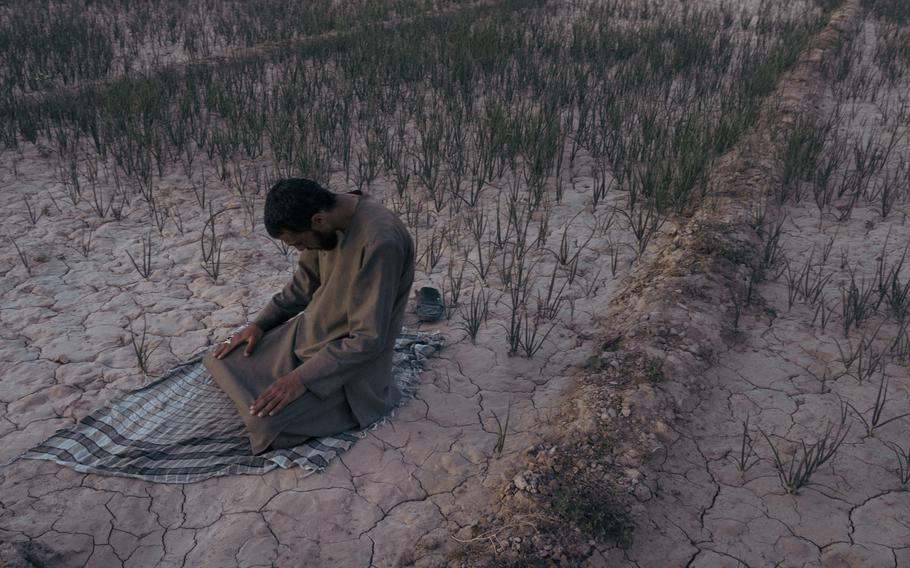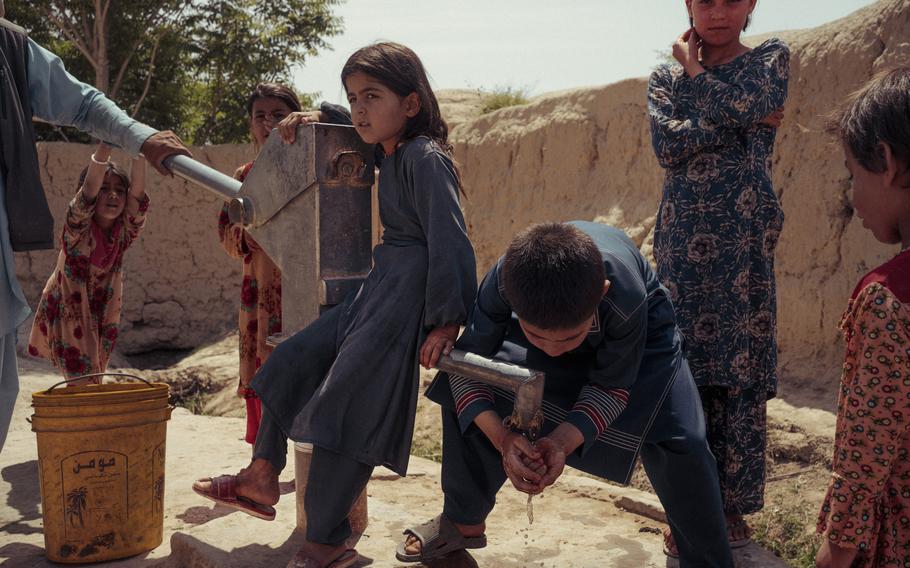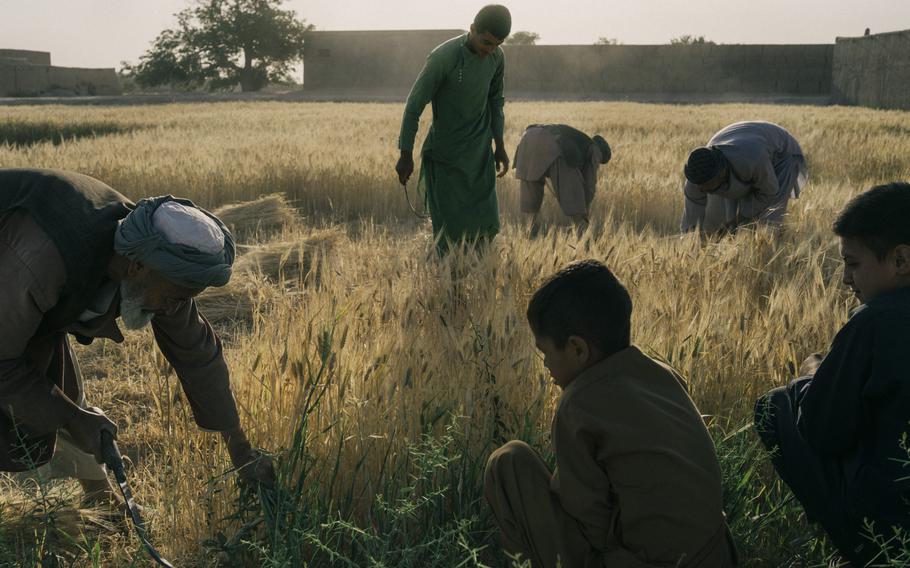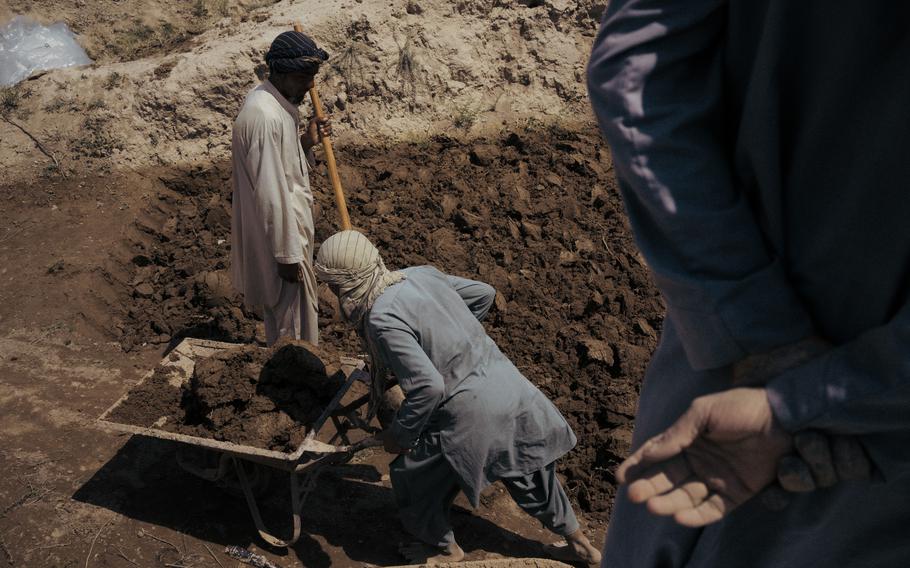
A farmer prays on a dried-out patch of land in Sholgara, an area affected by drought near the city of Mazar-e Sharif in northern Afghanistan, in April. (Lorenzo Tugnoli for The Washington Post)
AQCHA, Afghanistan — The morning sun was still rising over the shriveled wheat fields, and the villagers were already worrying about another day without water.
Rainwater stored in the village well would run out in 30 days, one farmer said nervously. The groundwater pumps gave nothing, complained another. The canals, brimming decades ago with melted snow from the Hindu Kush, now dry up by spring, said a third.
Village chief Mohammed Ishfaq threw his hands up. If everyone could hold out for two more years, he said, then the excavators and engineers — hundreds of them already working over the horizon — would arrive. "If we only had that water," Ishfaq said, "everything will be solved."
Two years after its takeover of Afghanistan, the Taliban are overseeing its first major infrastructure project, the 115-mile Qosh Tepa canal, designed to divert 20 percent of the water from the Amu Darya river across the parched plains of northern Afghanistan.
The canal promises to be a game changer for villages like Ishfaq's in Jowzjan province. Like elsewhere in the country, residents here are suffering from a confluence of worsening food shortages, four decades of war, three consecutive seasons of severe drought and a changing climate that has wreaked havoc on rainfall patterns. Average temperatures across Afghanistan have risen by 3.2 degrees Fahrenheit in the past 70 years, or twice the global average.
Once the canal is completed — provisionally, two years from now — it could irrigate 550,000 hectares (more than 2,100 square miles) of desert, effectively increasing Afghanistan's arable land by a third and even making the country self-sufficient in food production for the first time since the 1980s, according to Afghan officials and researchers. "It could impact every household in the country," said Zabibullah Miri, the project's head engineer at the state-owned National Development Corporation (NDC).
But for the internationally isolated Taliban, the canal represents a crucial test of its ability to govern.
The canal project was initially conceived in the 1970s under the first Afghan president, Mohammed Daoud Khan, and construction finally began in 2021 under the last, Ashraf Ghani. When the Taliban seized power in August 2021, they inherited the project and swiftly approved about $100 million for its construction, amounting to about a quarter of Afghanistan's yearly tax income.
About 6,000 workers are now operating excavators and heavy-duty trucks around-the-clock, working to carve a ditch 328 feet wide — wider than the California Aqueduct.

Children gather around a well to get water in the village of Qultagh. (Lorenzo Tugnoli for The Washington Post)
Taliban leaders have seized on the canal as a tool to burnish their image.
"Praise be to God, the work is progressing as planned," Abdul Ghani Baradar, the deputy prime minister and a senior Taliban leader, said in March during one of several site visits. The project would be completed "at any cost," he said on his page on X (formerly known as Twitter), which sometimes shares aerial footage of the construction, photos of Taliban officials surveying work and triumphant music.
"Qosh Tepa provides the Taliban with a good narrative: 'See, this is a project fully designed and fully funded by Afghans with no foreign support; we can do whatever the previous government couldn't with Western support,'" said Mohammed Faizee, a former deputy foreign minister under the previous Afghan government who was responsible for overseeing water and border issues.
The canal will be built and financed not by international aid but by Afghanistan's revenue from domestic coal mines, NDC officials say. But overseas Afghan experts say the country could face challenges not only in building the mega-canal — but also in operating it.
To save costs, the canal bed has not been sealed with cement, and along some stretches, briny groundwater has already seeped into the canal, tainting freshwater meant for irrigation.
Najibullah Sadid, a water resources engineer and researcher at the Federal Waterways Engineering and Research Institute in Germany, said feasibility studies have shown that 22 percent of water would be lost to seepage along some sections. Sediment might also clog the intake mechanism where the canal joins the Amu Darya, potentially requiring prohibitively expensive repairs, he said.
Sadid, who has previously trained employees at the Afghan Water Ministry, said he has held meetings with project officials in Afghanistan to show them his computer models, but got mostly blank feedback. "I don't think the canal authority has employees with specialized expertise," he said. "You need to be 100 percent sure with design. There's no such thing as random engineering."
Then there is the question of how much water Afghanistan will draw from the Amu Darya. Already, neighboring Uzbekistan and Turkmenistan have signaled their concerns that the reduced flow from the Amu Darya would affect their lucrative cotton fields. Uzbek Water Resources Minister Shavkat Khamraev said in June that a delegation had been sent to Kabul to convey Uzbek concerns.

Farmers harvest wheat in an area of Aqcha affected by drought near Mazar-e Sharif. The water resources in the area are so depleted that the wheat has no kernels and can only be used to feed farm animals. (Lorenzo Tugnoli for The Washington Post)
Faizee, the former diplomat, said he feared the Taliban lacked the diplomatic and technical expertise to negotiate over water, one of the most combustible points of friction in Central Asia, an increasingly parched region.
Afghanistan, preoccupied by internal conflict, has long struggled to assert its claims over transboundary water resources while its neighbors, including Iran, Uzbekistan and Turkmenistan, have used more than their fair share, Faizee said. Although four Central Asian Soviet republics signed an agreement to allocate the Amu Darya's water in 1987, the deal cut out Afghanistan.
If the new northern canal were not properly managed, Faizee said, it could lead to conflict like Afghanistan's perennial dispute over the Helmand River with Iran, which has sometimes led to Iranian residents attacking Afghan refugees and Iranian officials threatening to invade Afghanistan. After three border guards — two Iranian and one Afghan — were killed in a shootout in May, Iranian President Ebrahim Raisi traveled to the area to champion "the water rights of Iranians."
In a statement, Abdul Qahar Balkhi, a spokesman at the Afghan Foreign Ministry, acknowledged there were "questions" about the Taliban's ability to manage the canal and contain water disputes, but said they would be solved.
"The Islamic Emirate of Afghanistan retains experienced water management experts and remains committed to water rights of neighbors in line with existing treaties," Balkhi said. "As climate change has disproportionately harmed Afghanistan and the region due to consecutive drought years and depletion of water reserves, it is therefore vital that major carbon emitting countries take lead in tackling this crisis."
Today, construction has progressed about 100 miles, reaching deep into a part of Afghanistan that researchers say has become increasingly desertified over the past century.
Next to a turn in the Amu Darya, workers are still driving piles into the earth for the canal's intake. The first 30-mile stretch is already filled with groundwater, and workers have been experimenting with growing tree saplings along graded banks, next to towering sand dunes. After that, the canal dries out. The sun-blasted terrain seems devoid of life except for shrubs and construction workers toiling amid layers of sand and rock that blend into the sky.
Beyond the 100-mile mark, the canal remains but a plan. Ishfaq, the village chief, said he was told it would cross near the Aqcha bazaar, about a kilometer away, and surveyors had already come. But other villagers didn't know much about the project. They only knew how their land and their rivers have changed over two generations, and how badly they needed it.
The river water from central Afghanistan, which used to flow until August, now runs dry by March. Droughts used to occur once a decade, not every two years.
Even wheat crops failed, said Azizullah Walizada, 62, as he crumbled tassels in his fingers that were too dry to yield any grain. The northern drought began three years ago, and his income began to dwindle. Like other villagers, Walizada sold off his cattle to make money to buy food, keeping one last emaciated cow.
"Even the trees are dying," Walizada said.

Workers collect mud to build a wall in the village of Qultagh in Dawlatabad. In this village, the water from the wells is too acidic and salty because of depletion of water resources in the area. (Lorenzo Tugnoli for The Washington Post)